MAAM WWII Parade 2025: Convoy From The Past Conveys Lessons For The Future
READING, PA – During the Second World War, more than 1,600 Allied war correspondents were allowed unprecedented access to cover the historic conflict. This access was largely thanks to policies and actions put into place by commanding officers like Gen. Dwight D. Eisenhower.
A Google overview of that era tells us:
Supreme Headquarters Allied Expeditionary Force (SHAEF) issued war correspondent cards, also known as press passes, to journalists, photographers, and cameramen who were accredited to follow Allied troops and report on the war in Western Europe. These cards served as identification and allowed access to restricted areas.
The only hitch with this open book policy was that ticklish word “follow.” With few exceptions, the majority of correspondents were at the mechanized mercy of the army they were trying to follow. (Somehow, Stars and Stripes reporter – and legendary curmudgeon – Andy Rooney was given a jeep to use for the duration.)
I thought about this last weekend, as I contemplated writing about the annual MAAM WWII parade through Reading. The popular parade is always held the first week of June, in conjunction with the Anniversary of D-Day and the Mid-Atlantic Air Museum’s World War II Weekend.

Yes – I could have stood at the airfield gate to see the participants off, or greeted the convoy as it rolled into town. I could have also picked a spot along the six-mile route to wave as the parade passed by. Thankfully, my photographer/colleague Lady Camille was thinking along more historic lines.
Camille reasoned there was also the option to throw ourselves at the mechanized mercy of the army we hoped to follow. Luckily, a chance encounter – the night before the parade – set the wheels of participation in motion.
Endeavoring to walk off a late meal, we happened upon Matthew Atwood – a Pennsylvania State Constable and enthusiastic member of the reenacting community. Matt was standing beside his vintage jeep in the dim light of a Target parking lot in nearby Wyomissing. Once he affirmed that his jeep would be in the parade, I asked if he had room for two members of the press. Matt thought about the logistics for a moment, said he’d look at the group numbers once he got back to camp, then promised to try if at all possible to accommodate us. In the end that is what happened, after a bit of body shuffling with other members of his group: the 454th Bomb Group (reenacted).
(Note: If any of the 454th Bomb Group members got bumped at our expense, their next bottle of Yuengling is definitely on me.)
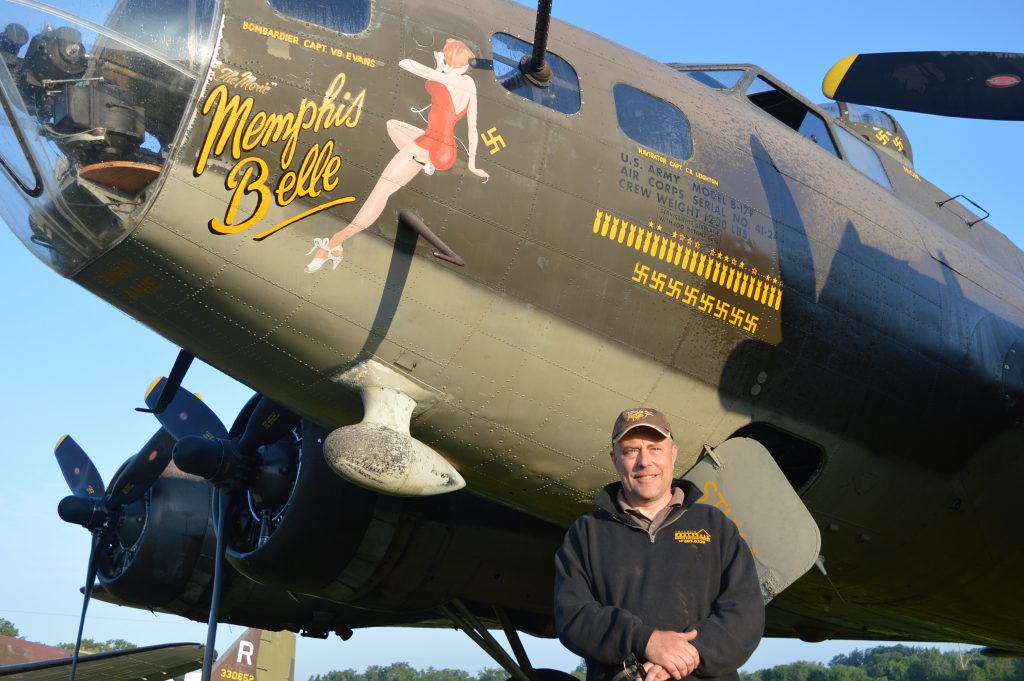
“I’ve loved Army Air Corps since I watched Memphis Belle as a kid,” explained Matt. “Watched that movie over and over and over. When I got a bit older, I helped with the military museum outside of Chicago; put together a uniform, came out here and inadvertently met this group. Got stationed in Alaska for three years, then came back, built my own uniform and everything differently. Again, I found this unit, and we just grew it from there. We’ve got tents, vehicles, assorted equipment and everything else.”
We asked Matt if his group had always focused on the bomb unit history, or if it was just a cadre of friends who enjoyed a variety of experiences through reenacting?
“It was a group of about 20 friends that enjoyed presenting and preserving the history by doing the events. My biggest thing is preserving the history. Like the bomb trailer we have over there. It was in a lot worse shape than you see it now. Same with the Jeep you saw last night; same with everything else we find. They’re not building any more of this equipment.”
“This bomb group, the 454th, does have a lot of history. One of our members actually has a personal attachment to the 454th. We (the Capital Wing of the Airmen’s Preservation Society) do Army Air Corps. So, each event, we typically do a different unit. But for this particular show, we always fall in with the 454th, and honor that member’s grandparent.”
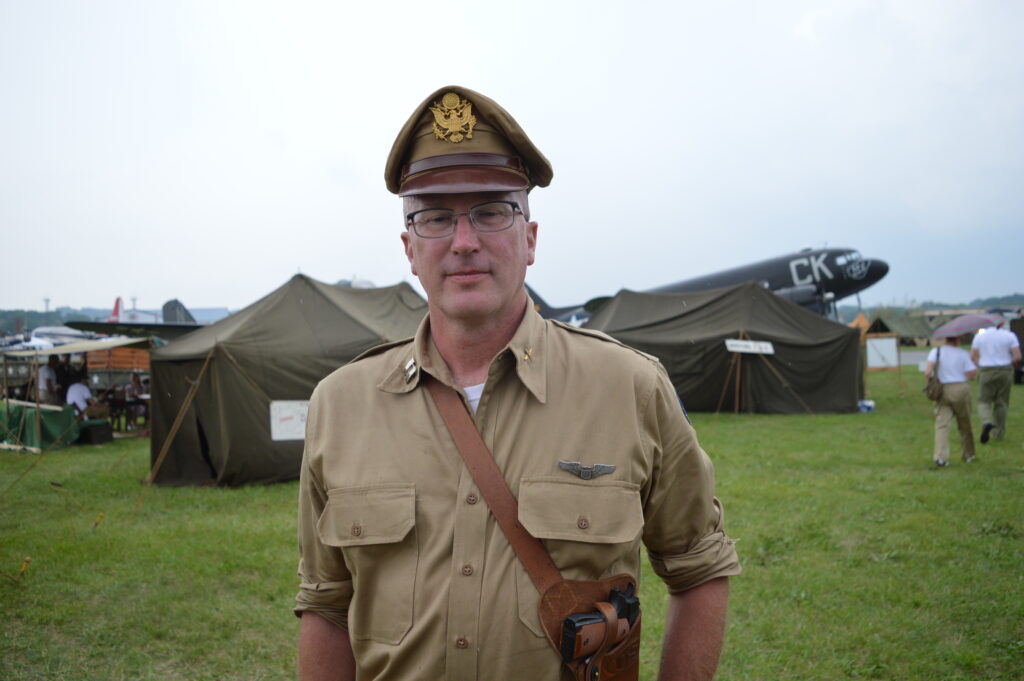
With that brief introduction, we were off for the parade.
Almost.
Before we could go, our vintage ride required a quick jump-start for the battery.
“I’ve had this Jeep probably since the 90s,” said our driver, Rob Rumbold, as his teen-aged son, Will, lowered the hood over the now humming engine. “It’s a Willys-Overland, and the gentleman that started the company I worked for at the time was using it as a hunting jeep. He sold his place, and then he goes, ‘Hey, you need a jeep? Well, you can have mine.’ I said, ‘I can afford that!’ And we put it back into World War II looking condition.”
Rob told us that – while he has been bringing Will to events at MAAM for at least 15 years – he has actually been a regular at the WWII Weekend since coming in the 90s with his own late father. As for his interest in reenacting?
“I was with a different group when I first got started. For a while, we were just with a vehicle group. And then, because I like the Air Corps and had the (deactivated) bomb, we hooked up with an Air Corps group.
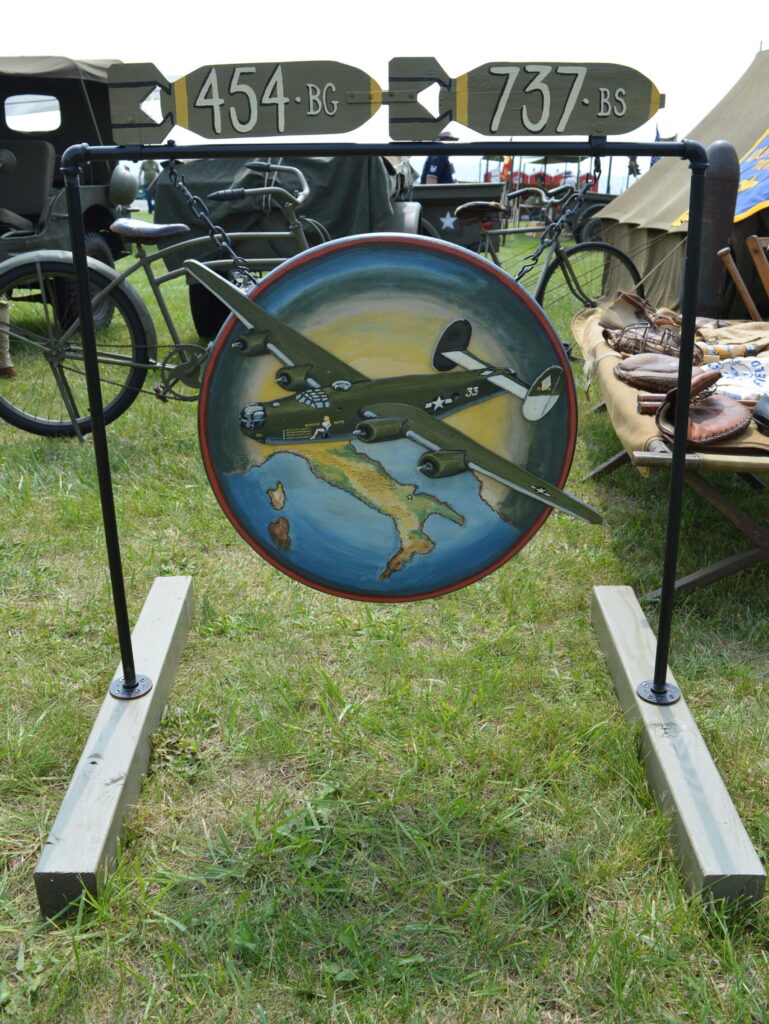
“The advantage to being in this particular group is that, if somebody walks into the camp and starts asking questions, we’re ready with answers. If you put me in a Marine Corps Camp, I’d have no idea how to answer any of those questions. My dad was in the Air Corps, and since I have some experience researching what we’ve done, I can answer air power questions better. For example, the one bomb that’s right in front of us is our (deactivated) bomb. It’s a 1000 pound bomb, which would have been dropped by a heavy bomber, like a B-17 or a B-24. Bombs like this were mainly used on concrete bunkers and placements – they’re not really anti-personnel weapons.”
Rob asked if I was a veteran, and I told him that covering the 2015 Battle of Baltimore was combat experience enough for me. Some more small talk — along with waving to the crowd — filled the remainder of our drive into Reading. Being placed where we were in the parade, it was difficult to guess how many other vehicles had fallen into line. I guessed around 35, but Rob correctly reckoned the total was closer to 50.
Local law enforcement led the way, creating a safe avenue for our clamorous convoy of military jeeps, armored personnel carriers, flat-bed trucks and vintage sedans. Two of the prettier members of the 454th rode in on bomb trollies. There were also a number of motorcycles and sidecars (both Allied and German). Sturgis regulars would have oohed over the cycles, then approvingly nodded at the camaraderie which unfolded between the battle-ready bikers.
When we arrived at the town center, everyone dismounted and began to mill about. Several dignitaries spoke about the importance of the annual event. A five-piece combo called “The Snack Club” provided live jazz music, which contributed to the festive atmosphere. And I would be remiss if I didn’t give a shout to Patton reenactor, Denny Hair, who delighted the crowd when he sat in with the band. Check out the video below from last year’s parade, where Denny played drums on their rendition of “My Satin Doll.”
The mutual welcome continued as reenactors chatted up Reading residents who gathered about the antique armada. And local vets kicked in, too – offering insights from their own experience.
Staff Sgt. (Ret) Charles Hagans, Sr., from York, PA., busied himself as impromptu guide for the friends he was with; comparing the Desert Storm-era Army of his service years with the uniforms and equipment he saw on parade.
“I was stationed at Ft. Hood in Texas, which was the base of the III Armored Division. So, the markings on a number of the vehicles are familiar to me, even though some of what I’m seeing probably goes back to World War I,” observed Hagans.
Another local who enjoyed the military tribute was Vietnam veteran, Joe Wrede. Wrede told us his overseas service from 1971-72 was primarily at the U.S. Air Force base at Phan Rang.
“Phan Rang was a forward base during the U.S. involvement. When we started to withdraw, I was one of the last 40-or-so of us during the transition to the Republic of Vietnam Air Force. Most everyone else had moved on from Saigon, but I couldn’t get back out from there. There were just too many people trying to leave the country. I had to go to Ton Son to get out of Vietnam.”
Wrede said he was lucky to have escaped the war in the manner that he did, but he believes that the chemicals he handled by the barrel full, while stationed at Phan Rang, led to some of the health issues he is dealing with today. As for the happy diversion offered by the parade?
“I hope they keep having it. I like it a lot. I guess as long as the vehicles last and there’s somebody to do it.”
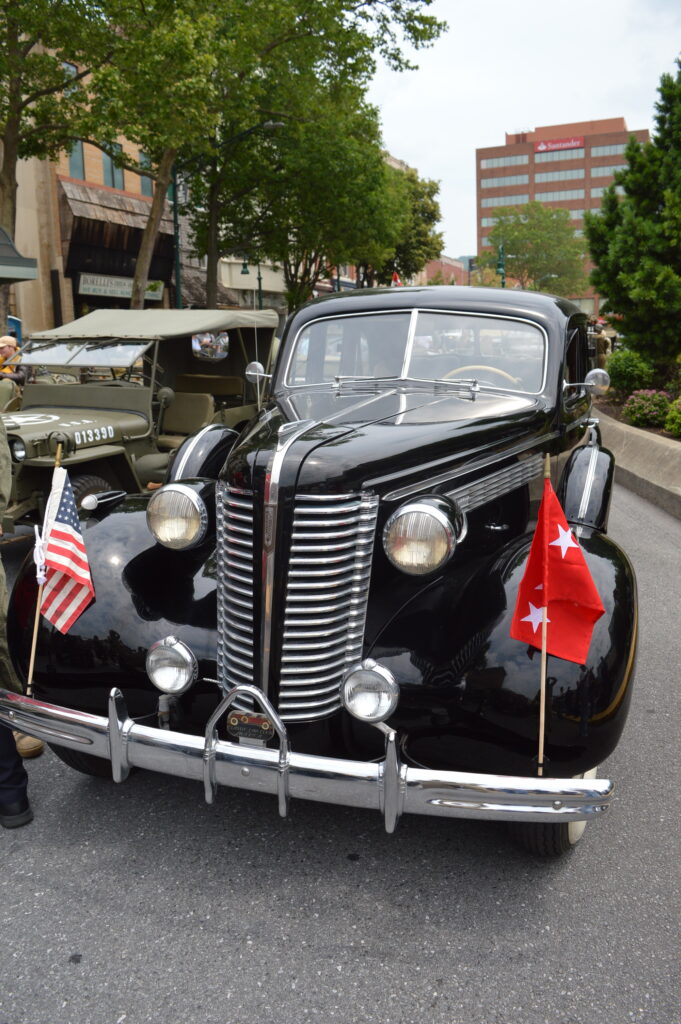
While the parade vehicles were mostly painted olive drab, there was a sprinkling of battleship gray jeeps, which would have been used by naval entities like the Shore Patrol. Perfect for a parade which included historic U.S. Navy war heroes.
One such hero is Lt. Cmdr. John F. Kennedy, as portrayed by former New Yorker Frederick J. Seitz III.
“I’m originally from New York but moved to Florida and retired,” offered Seitz. “I just enjoy this era and grew up surrounded by relatives who fought the Second World War. It’s always been my niche in history, the 1940s and 1950s. I’ve been an avid scale modeler since I was a kid, and that kind of morphed into reenacting, or what my wife says is a form of insanity (laughing). I guess there’s a lot of worse things I could be involved with.”
In noting his resemblance to JFK, Seitz told us that he looked even more like Kennedy when he was younger, but has had the benefit of aging which was denied the youthful president. As for particular memories from his many WWII Weekend appearances?
“After so many years, I would say that the weekends seem to run together, so after a while, it’s hard to pick out what happened on one specific weekend. But I would say the biggest thing for me personally is to come here and share with other people who are insane, like me. People who suffer from this insanity of the study and the love of history. We just chat during the day as I walk around the airfield, and people pick it up a notch with 1940s era dancing and the whole nine yards.
“That’s really what it comes down to – fun and learning. Just because I know this much about this era doesn’t mean I can’t learn from others. Maybe I could teach somebody about John Kennedy – maybe I can learn from someone else. That’s also a big part of my desire to be here too.”

One of the unexpected aspects of participating in this year’s parade was seeing firsthand how a column of military vehicles from the past helps to build a bridge to the future. This was noticeable, as the parade route both into and out of town was lined with families with small children. It was also clear, as we spoke with participants such as Matt Atwood, Rob Rumbold and Fredrick Seitz: people whose interest in history started at a young age, and evolved from their exposure to past events and people – largely thanks to their parents and extended families.
Andrew Hollinger – a member of the Headquarters Company of the 101st Airborne Division (reenacted) – told us that, while he was participating in his first parade for WWII Weekend, he was no stranger to MAAM and its WWII camp life.
“I’ve been going to the show for years with my dad and my grandpa; seeing the guys in the tents with all the gear. And that’s when the vets were around too. We used to hang around and listen to their stories and started to like the camp life. So, I got involved with the 101st Airborne group.
“These guys have jeeps and other vehicles, and they were willing to let us drive them out here. So, this is my first parade after some 15 years of being involved with the show. It’s a nice, nice trip through town; bringing everybody up, piling them in here and seeing the sights. It’s a great time. And we’re only halfway done. We’ve got to make it back – make sure we’re all in one piece.”
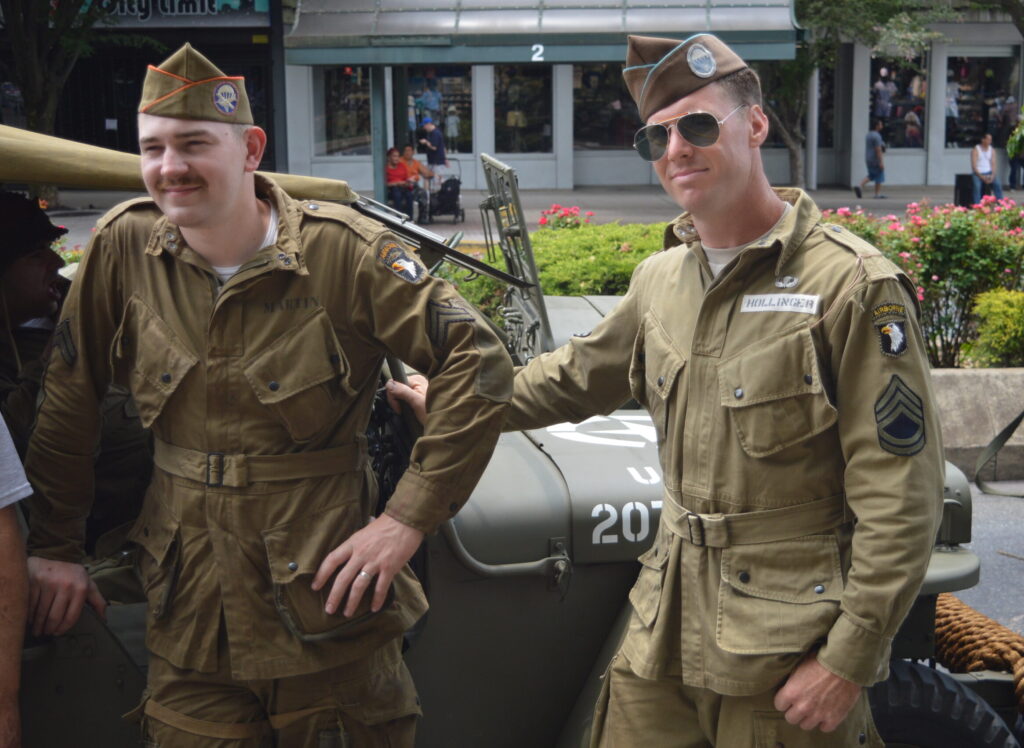
Kathryn Davis – Miss Greater Reading Teen 2025 – echoed the exuberance of Andrew and other younger participants, while bringing it all back to the true value of this annual event.
“Well, this isn’t my first parade, and this isn’t my first air show. I’ve been coming to the Reading Air Show and World War II Weekend since I was quite little. And that’s something I appreciate so much.
“What I love about this is we’re not only honoring generations past; we are really fostering generations of the future. The importance of that to me – growing up with essentially no connection to that era – other than my great-grandfather fighting in World War Two – is very clear. Most kids don’t have a personal connection, and this event is a really great way for kids to learn about this important history and why we have the freedoms we have today.”
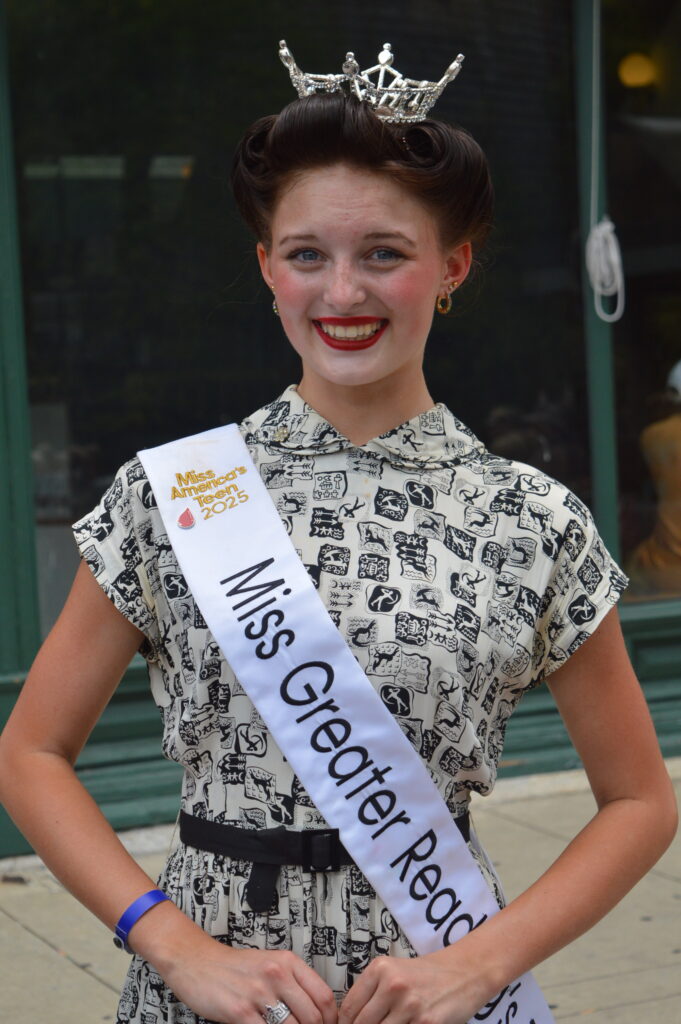
Wrapping things up in Reading, we re-entered the relative comfort of the back seat of Rob Rumbold’s Jeep and returned to MAAM to the cheers of an equally enthusiastic crowd.
Was the experience worth this reporter’s effort to secure a ride into Reading? Absolutely! And I would do it again in a heartbeat. After all, when was the last time a member of the working press arrived anywhere to the sound of a cheering crowd?
All kidding aside, Camille and I are truly grateful to Matt Atwood, Rob and Will Rumbold, and the members of the 454th Bomb Group for making that experience happen.
Still, I wonder how a curmudgeon like Andy Rooney secured his own jeep to cover the war?
Perhaps that will be my story for next year’s World War II Weekend.
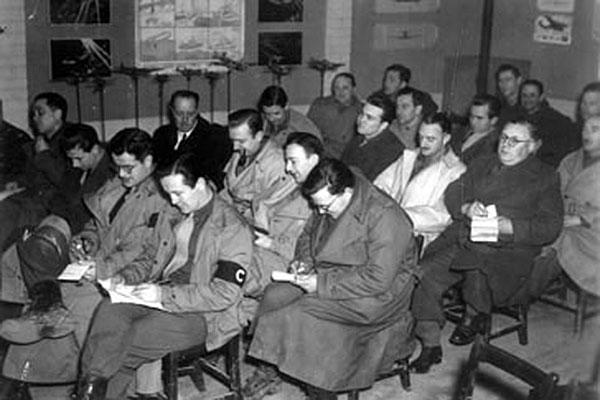
© Copyright 2025 Baltimore Post-Examiner. All Rights Reserved

Anthony C. Hayes is an actor, author, raconteur, rapscallion and bon vivant. A one-time newsboy for the Evening Sun and professional presence at the Washington Herald, Tony’s poetry, photography, humor, and prose have also been featured in Smile, Hon, You’re in Baltimore!, Destination Maryland, Magic Octopus Magazine, Los Angeles Post-Examiner, Voice of Baltimore, SmartCEO, Alvarez Fiction, and Tales of Blood and Roses. If you notice that his work has been purloined, please let him know. As the Good Book says, “Thou shalt not steal.”
